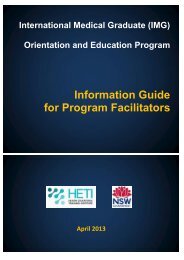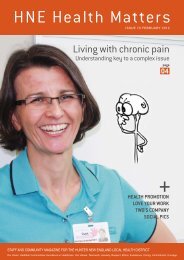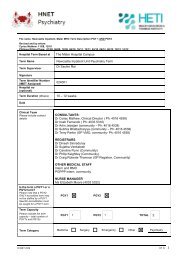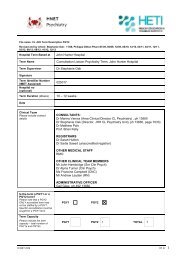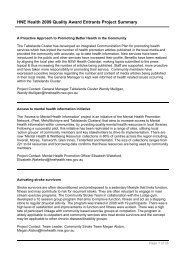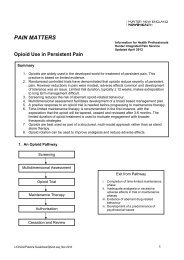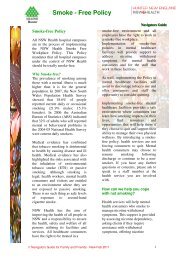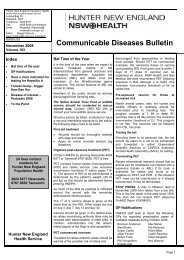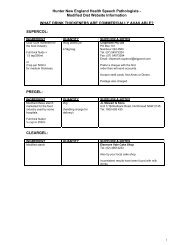March 2013 - Hunter New England Health - NSW Government
March 2013 - Hunter New England Health - NSW Government
March 2013 - Hunter New England Health - NSW Government
You also want an ePaper? Increase the reach of your titles
YUMPU automatically turns print PDFs into web optimized ePapers that Google loves.
dow<br />
Project officer, Community Falls injury prevention<br />
strategies, sue green<br />
into programs that will help them develop their<br />
balance and leg strength.”<br />
This brings us to the heart of Sue Green’s<br />
work. For the last two years, she has been<br />
connecting with providers of community-based<br />
exercise programs across our district and<br />
encouraging them to list their programs in the<br />
<strong>NSW</strong> <strong>Health</strong> ‘Active and <strong>Health</strong>y’ web-based<br />
directory (www.activeandhealthy.nsw.gov.au).<br />
The site is easy to use. Just enter your<br />
suburb or town and you can find a range of<br />
exercise programs available in locations most<br />
convenient for you.<br />
“We want everyone to know about the Active<br />
and <strong>Health</strong>y site,” Sue said.<br />
As part of the Preventive Care program<br />
everybody who comes into contact with <strong>Hunter</strong><br />
<strong>New</strong> <strong>England</strong> Community <strong>Health</strong> Services is<br />
screened for health risk behaviours, including<br />
the risk of falling.<br />
“For people over 50 at low risk of falls, our<br />
advice is to go off and engage in communitybased<br />
programs, but it’s not just about physical<br />
activity. They need to challenge their balance,<br />
improve their leg strength and ideally, they need<br />
to devote two hours a week,” Sue said.<br />
<strong>Hunter</strong> <strong>New</strong> <strong>England</strong> <strong>Health</strong> has devised<br />
exercise programs which specifically cater for<br />
the needs of people aged 50 plus, including<br />
‘Active Over 50’s' in the <strong>Hunter</strong> and Lower Mid<br />
North Coast and ‘Balance and strength’ across<br />
<strong>New</strong> <strong>England</strong>, which are supported by external<br />
programs such as Heart Moves from the Heart<br />
Foundation. <strong>Health</strong> also offers support to<br />
a range of private providers to start up new<br />
programs in towns where programs are not<br />
currently available.<br />
“Sometimes we recognise that external<br />
programs don’t include enough balance and<br />
strength content and we work with these<br />
providers to re-design their activities,” says Sue.<br />
There is no re-design is necessary when<br />
it comes to Tai Chi. This graceful and<br />
deceptively simple Chinese martial art<br />
consistently shows evidence that participation<br />
reduces the risk of falls.<br />
Accredited Tai Chi providers across <strong>Hunter</strong><br />
<strong>New</strong> <strong>England</strong> see regular classes of older<br />
locals, going through the gentle movements<br />
that have such an impact on the quality of their<br />
lives.<br />
Nearly any activity which keeps us on our<br />
feet and moving can help to maintain good<br />
balance. In Tai Chi, people not only bend<br />
off centre and test their balance; they also<br />
improve leg strength through bending and<br />
stepping. Yoga, Pilates and Dance are among<br />
other activities which help to enhance balance.<br />
The Population <strong>Health</strong> experts are looking<br />
for one or more of these routines, when<br />
they assess the external programs for their<br />
potential to build balance and strength.<br />
“We have identified external accredited<br />
providers whose exercise programs will<br />
develop balance and leg strength,” Sue said.<br />
“We ask these providers to make sure that<br />
their programs are listed in the Active and<br />
<strong>Health</strong>y website, using the site’s home page<br />
registration function.<br />
“Whenever they change their classes, they can<br />
update their entry.”<br />
Regardless of age, weight, health problems<br />
or abilities, it is important for people aged<br />
over 50 to continue to be as physically active<br />
as possible, to help maintain their health and<br />
independence.<br />
“We try to get the word out to the community,<br />
before people become sedentary or overweight.<br />
“But even for those people who have become<br />
sedentary, small changes can make a big<br />
difference and all these efforts to maintain<br />
balance and leg strength can help people<br />
maintain independence in their own home.<br />
“Getting involved in some form of exercise<br />
can also put you in a better frame of mind, it<br />
can increase your confidence at home and in<br />
public and when you get involved in exercise<br />
programs, you widen your social circle.”<br />
“It doesn’t have to be a group exercise program,<br />
but these programs are a chance to meet<br />
new people and have a bit of fun and that’s<br />
motivation to continue attending.”<br />
In the perfect world, exercise is a lifelong pursuit,<br />
but it’s not always possible. The trouble is there<br />
are drawbacks if we don’t keep active.<br />
Societies are looking at simple ideas around<br />
the importance of standing, rather than sitting.<br />
Suggestions include workplace meetings where<br />
people stand rather than sit and meetings<br />
conducted while teams are out walking.<br />
Find some tips below on how to review your<br />
basic routine.<br />
How to stay<br />
balanced<br />
Exercises which challenge balance are<br />
those where people:<br />
• Stand with feet close together or on<br />
one leg (movement from one leg to<br />
the other).<br />
• Undertake exercises while standing<br />
with minimum use of hands to assist.<br />
• Undertake exercises with controlled<br />
movement of the whole body<br />
while standing (e.g. reaching while<br />
standing).<br />
You can inlcude specific balance exercises<br />
in your daily routine. For example:<br />
• Heel to toe standing<br />
• Knee raises<br />
• Heel to toe walking<br />
• Side leg raises<br />
• Sideways walking<br />
• Heel raises<br />
• Stepping up a step<br />
• Sit to stand exercises.<br />
hnehealth.nsw.gov.au 5



